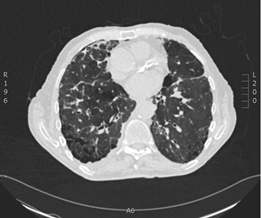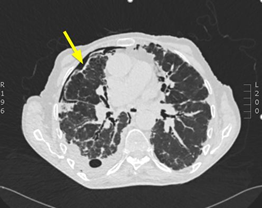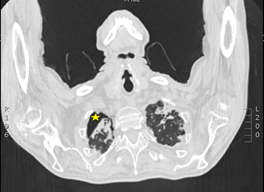Pleuroparenchymal Fibroelastosis with a positive p-ANCA
Ali Muzzammil*, Karunatilleke Anne, Shah Palak, Dhamrait Bajinder
University Hospitals Birmingham, NHS Foundation Trust, UK
*Corresponding Author: Dr. Muzzammil Ali, University Hospitals Birmingham, NHS Foundation Trust, UK
Received: 24 January 2019; Accepted: 07 February 2019; Published: 05 March 2019
Article Information
Citation: Ali Muzzammil, Karunatilleke Anne, Shah Palak, Dhamrait Bajinder. Pleuroparenchymal Fibroelastosis with a positive p-ANCA. Archives of Clinical and Medical Case Reports 3 (2019): 51-54.
View / Download Pdf Share at FacebookKeywords
Pneumothorax, corticosteroids, hypersensitivity pneumonitis
Pneumothorax articles Pneumothorax Research articles Pneumothorax review articles Pneumothorax PubMed articles Pneumothorax PubMed Central articles Pneumothorax 2023 articles Pneumothorax 2024 articles Pneumothorax Scopus articles Pneumothorax impact factor journals Pneumothorax Scopus journals Pneumothorax PubMed journals Pneumothorax medical journals Pneumothorax free journals Pneumothorax best journals Pneumothorax top journals Pneumothorax free medical journals Pneumothorax famous journals Pneumothorax Google Scholar indexed journals corticosteroids articles corticosteroids Research articles corticosteroids review articles corticosteroids PubMed articles corticosteroids PubMed Central articles corticosteroids 2023 articles corticosteroids 2024 articles corticosteroids Scopus articles corticosteroids impact factor journals corticosteroids Scopus journals corticosteroids PubMed journals corticosteroids medical journals corticosteroids free journals corticosteroids best journals corticosteroids top journals corticosteroids free medical journals corticosteroids famous journals corticosteroids Google Scholar indexed journals hypersensitivity pneumonitis articles hypersensitivity pneumonitis Research articles hypersensitivity pneumonitis review articles hypersensitivity pneumonitis PubMed articles hypersensitivity pneumonitis PubMed Central articles hypersensitivity pneumonitis 2023 articles hypersensitivity pneumonitis 2024 articles hypersensitivity pneumonitis Scopus articles hypersensitivity pneumonitis impact factor journals hypersensitivity pneumonitis Scopus journals hypersensitivity pneumonitis PubMed journals hypersensitivity pneumonitis medical journals hypersensitivity pneumonitis free journals hypersensitivity pneumonitis best journals hypersensitivity pneumonitis top journals hypersensitivity pneumonitis free medical journals hypersensitivity pneumonitis famous journals hypersensitivity pneumonitis Google Scholar indexed journals health articles health Research articles health review articles health PubMed articles health PubMed Central articles health 2023 articles health 2024 articles health Scopus articles health impact factor journals health Scopus journals health PubMed journals health medical journals health free journals health best journals health top journals health free medical journals health famous journals health Google Scholar indexed journals p-ANCA articles p-ANCA Research articles p-ANCA review articles p-ANCA PubMed articles p-ANCA PubMed Central articles p-ANCA 2023 articles p-ANCA 2024 articles p-ANCA Scopus articles p-ANCA impact factor journals p-ANCA Scopus journals p-ANCA PubMed journals p-ANCA medical journals p-ANCA free journals p-ANCA best journals p-ANCA top journals p-ANCA free medical journals p-ANCA famous journals p-ANCA Google Scholar indexed journals Fibroelastosis articles Fibroelastosis Research articles Fibroelastosis review articles Fibroelastosis PubMed articles Fibroelastosis PubMed Central articles Fibroelastosis 2023 articles Fibroelastosis 2024 articles Fibroelastosis Scopus articles Fibroelastosis impact factor journals Fibroelastosis Scopus journals Fibroelastosis PubMed journals Fibroelastosis medical journals Fibroelastosis free journals Fibroelastosis best journals Fibroelastosis top journals Fibroelastosis free medical journals Fibroelastosis famous journals Fibroelastosis Google Scholar indexed journals COPD articles COPD Research articles COPD review articles COPD PubMed articles COPD PubMed Central articles COPD 2023 articles COPD 2024 articles COPD Scopus articles COPD impact factor journals COPD Scopus journals COPD PubMed journals COPD medical journals COPD free journals COPD best journals COPD top journals COPD free medical journals COPD famous journals COPD Google Scholar indexed journals patient articles patient Research articles patient review articles patient PubMed articles patient PubMed Central articles patient 2023 articles patient 2024 articles patient Scopus articles patient impact factor journals patient Scopus journals patient PubMed journals patient medical journals patient free journals patient best journals patient top journals patient free medical journals patient famous journals patient Google Scholar indexed journals medicine articles medicine Research articles medicine review articles medicine PubMed articles medicine PubMed Central articles medicine 2023 articles medicine 2024 articles medicine Scopus articles medicine impact factor journals medicine Scopus journals medicine PubMed journals medicine medical journals medicine free journals medicine best journals medicine top journals medicine free medical journals medicine famous journals medicine Google Scholar indexed journals CNS articles CNS Research articles CNS review articles CNS PubMed articles CNS PubMed Central articles CNS 2023 articles CNS 2024 articles CNS Scopus articles CNS impact factor journals CNS Scopus journals CNS PubMed journals CNS medical journals CNS free journals CNS best journals CNS top journals CNS free medical journals CNS famous journals CNS Google Scholar indexed journals
Article Details
1. Case Presentation
An 84-year-old gentleman was admitted to hospital with a four-week history of progressive shortness of breath. He was an ex-smoker with a background of severe COPD and subpleural upper zone fibrosis. He had an extensive occupational history that included exposure to pigeons, tyre materials, cast iron dust, cleaning products, wood dust, petrol fumes and hay. Recent outpatient spirometry had shown a general decline in his lung function over the course of 4-months; his FEV1 decreased from 1.03L to 0.73L and his FVC decreased from 1.97L to 1.26L. In the days leading up to his admission, he required frequent use of his ambulatory oxygen for symptomatic relief.
On clinical examination he was dyspnoeic at rest. There were no features of connective tissue disease (CTD). His blood gas showed type 1 respiratory failure and he was therefore managed with oxygen. Although his haematology and biochemistry blood results were unremarkable, his MPO-ANCA titre was positive at 48.0 EU. His CXR showed marked bilateral pleural thickening and a small right-sided pneumothorax. A subsequent CT-thorax confirmed these changes and also revealed advanced apical fibrosis and traction bronchiectasis [Figure 1-3]. These are classical radiological features of pleuroparenchymal fibroelastosis (PPFE). Profound desaturation off of oxygen however required a repeat CT-thorax 2-weeks later. This showed similar stable appearances to the previous CT.
Extensive discussion in the respiratory MDT refined the diagnosis as PPFE. He was therefore started on long-term corticosteroids. The association between MPO-ANCA and PPFE was unclear and may have been coincidental. Although the differential diagnosis was broad and included an exacerbation of COPD, pulmonary embolism, interstitial lung disease or hypersensitivity pneumonitis, the patient’s history, examination and investigation findings made all of these diagnoses unlikely. Furthermore, because of his frailty and poor lung function, it was inappropriate to perform a diagnostic lung biopsy. Nevertheless, he improved symptomatically with steroids and was later discharged home on long-term oxygen therapy.

Figure 1: CT-Thorax showing traction bronchiectasis, widespread emphysema and reticular abnormalities.

Figure 2: CT-Thorax showing pleural thickening and right-sided pneumothorax (arrow).

Figure 3: CT-Thorax showing apical lung fibrosis and right-sided pneumothorax (asterix).
PPFE is a rare disease which is characterized by progressive fibroelastosis of the visceral and subpleural parenchyma of the upper lobes of the lung [1]. It often presents with dyspnoea, cough and weight loss which makes it difficult to differentiate from other respiratory complaints. Although the aetiology is unclear, many cases have been associated with bone marrow transplantations, chemotherapy, occupational exposure and chronic infections [1, 2]. Some cases have also suggested a genetic predisposition and a possible association with CTDs such as ankylosing spondylitis [1, 2].
Although our patient had a positive MPO-ANCA, he showed no features of autoimmune disease. Furthermore his radiological pattern of fibrosis was unusual of CTD-associated pulmonary fibrosis which is usual interstitial pneumonia. Therefore the likely aetiology of PPFE in his case was either idiopathic or secondary to his previous occupational exposure. In PPFE, CXR findings include marked bilateral apical pleural thickening and pneumothoraces [1]. Classical CT findings include similar features and also traction bronchiectasis, reticular abnormalities and lymphadenopathy [1]. Although a surgical lung biopsy is required for a definite diagnosis, this can be impractical as many patients are often not suitable for surgery. In these cases, a diagnosis is made in an MDT setting contextualizing the investigative findings with the patient’s background.
The prognosis of PPFE is variable [2, 3]. Although no specific treatment has been shown to modify the progression of disease, empirical treatment with corticosteroids, immunosuppressive agents and N-acetylcysteine have shown some transient benefit in other case reports [1, 3]. Lung transplantation is a potential option in surgically fit candidates.
2. Learning Points/Take Home Messages
- PPFE is a rare, progressive lung disease involving the pleura and parenchyma of the lung. It predominately affects the upper lobes and is associated with scarring and elastosis. While its aetiology is unclear, it has many well-established associations. It presents similarly to many common respiratory conditions and can pose a diagnostic dilemma. A common first presentation is a secondary pneumothorax.
- Many patients with PPFE are unfit for surgery. Therefore a tissue diagnosis is not feasible. In these cases a diagnosis is made by contextualising the investigative results against the patient's background.
- The correlation between MPO-ANCA and PPFE is unclear. While MPO-ANCA positivity is an unfavourable prognostic factor in patients with pulmonary fibrosis, the radio-pathological pattern of the fibrosis is usual interstitial pneumonia rather than that seen in PPFE. Furthermore, while pulmonary fibrosis can be associated with all CTDs, patients must have findings of autoimmune disease with interstitial pneumonia for this likelihood to be considered.
References
- Reddy TL, Tominaga M, Hansell DM, et al. Pleuroparenchymal fibroelastosis: a spectrum of histopathological and imaging phenotypes. Eur Respir J 40 (2012): 377-385
- Watanabe K. Pleuroparenchymal fibroelastosis: its clinical characteristics. Curr Respir Med Rev 9 (2013): 299-237.
- Nakatani T, Arai T, Kitaichi M, et al. Pleuroparenchymal fibroelastosis from a consecutive database: a rare disease entity? Eur Respir J 45 (2015): 1183-1186.


 Impact Factor: * 5.31
Impact Factor: * 5.31 Acceptance Rate: 75.63%
Acceptance Rate: 75.63%  Time to first decision: 10.4 days
Time to first decision: 10.4 days  Time from article received to acceptance: 2-3 weeks
Time from article received to acceptance: 2-3 weeks 
